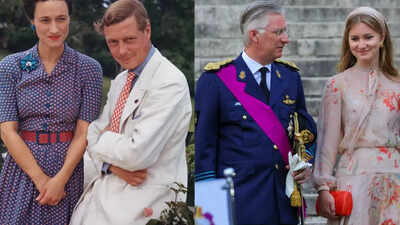ARTICLE AD BOX

Seems like yet another royal abdication is on the cards.But this time, it’s not for the British royal family. King Philippe, the monarch of Belgium, recently opened up about when he might renounce the throne for his daughter, Princess Elisabeth, to reign.Read on to know more.
What’s happening?
King Philippe of Belgium recently had some fun while tackling a question about when he might hand over the throne to his daughter, Princess Elisabeth. The 65-year-old monarch shared his thoughts in a cheerful interview released by The Belgian Monarchy, where he responded to 30 out of a whopping 2,614 video messages for his April 15 birthday.
When asked about abdication, King Philippe offered a playful take on the idea: "A King steps back, but is not retired," according to a translation shared by Hola!.
He emphasized that he would continue his royal duties while allowing his daughter the time she needs to enjoy life, grow, and travel the world. "I will continue to work for Belgium, and I must give my daughter time to enjoy her youth, develop herself, and see the world.
I support her 100 percent in that, and I will do everything I can to give her all the time she needs to do," he added.

Now, let’s take a look at abidication, as a royal precedent.
Edward VIII’s dramatic exit

In December 1936, Edward VIII shocked the world by relinquishing the British throne after less than a year in power. His abdication, driven by an irreconcilable desire to marry Wallis Simpson, a twice-divorced American, defied centuries of monarchical tradition. Reportedly, the King famously told his prime minister: “I find it impossible to carry the heavy burden of responsibility and to discharge my duties as King….
.without the help and support of the woman I love.” The crisis was swift and seismic; Edward stepped away, becoming the Duke of Windsor, and was succeeded by his younger brother, George VI. His departure set one of the starkest examples of a voluntary surrender of power in modern monarchy, born of personal conviction, not political calculus.
Belgium’s history of ‘peaceful’ abdications

Fast-forward to July 2013: King Albert II of Belgium voluntarily abdicated in favor of his son, Prince Philippe.
After nearly 20 years on the throne, Albert cited age and declining health as his reasons, believing that he could no longer “fulfil [his] duties as [he] would like to,” and expressing confidence that his son was “well prepared” to take up the constitutional role. The ceremony was somber yet celebratory – Belgian flags, parliamentary oaths in three languages, and poignant tributes to national unity amid deep linguistic divisions.
King Philippe: The son who inherited the crown

On 21 July 2013 – Belgium’s national day – Philippe, then aged 53, was sworn in as the seventh King of the Belgians. An Oxford- and Stanford-trained former military pilot, he pledged to uphold the constitution and act as a unifying figure in a country often split by language and regional identity. His reign, so far, has been quiet, dutiful, and low‑profile – quite unlike the conspicuous drama surrounding Edward VIII’s abdication and departure to a more gilded, yet detached, existence.
The modern wave of abdications
Belgium’s abdication was neither isolated nor unprecedented. In recent years, a wave of European monarchs has offered their thrones to the next generation. Emperor Akihito of Japan abdicated in 2019 due to age and health – his first voluntary exit in over two centuries. Queen Beatrix of the Netherlands passed the throne to her son in 2013; her successor, King Albert II, followed suit. Queen Margrethe II of Denmark abdicated in early 2024 – likely aiming to ensure her son, Crown Prince Frederik, could begin his reign at full strength amid swirling speculation surrounding his personal life.

While it’s near-impossible to think of a similar kind of scenario for King Charles III, the reigning monarch of the United Kingdom – even though he is suffering from cancer – these abdications reflect a modern view: monarchs, living longer and more active lives, may choose to step aside when they feel they can no longer perform ceremonial duties with distinction. It’s a renewal strategy – passing the torch while still alive to advise and support.
Paving the path for Princess Elisabeth
A decade before Princess Elisabeth was born, Belgium made a significant change to its succession laws, adopting absolute primogeniture in 1991. This meant that female descendants of King Albert II would inherit the throne based on birth order, breaking the centuries-old rule that favored sons.

King Philippe and Queen Mathilde are raising their four children, including Princess Elisabeth, Prince Gabriel, 21, Prince Emmanuel, 19, and Princess Eléonore, 17, all while balancing their education and royal responsibilities.At just 23 years old, Princess Elisabeth, who’s also known as the Duchess of Brabant, is the first in line to the throne and making history as Belgium’s first queen regnant – its first reigning female monarch! True to her royal spirit, Princess Elisabeth is actively juggling her studies with royal duties, frequently returning to Belgium to stay engaged with public life. It’d be premature to draw a conclusion if King Philippe would be renouncing the throne for his daughter, but it’s safe to say she’s a busy princess making her mark!
Mumbai: Queen Mathilde of Belgium enjoys a splendid musical performance by kids



.png)
.png)
.png)
















 3 hours ago
5
3 hours ago
5









 English (US) ·
English (US) ·